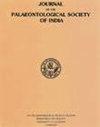Recent pollen spectra from Shimla water catchment sanctuary, Kufri (HP): Implications to interpret Holocene pollen records
IF 0.6
4区 地球科学
Q4 PALEONTOLOGY
Journal of the Palaeontological Society of India
Pub Date : 2023-10-26
DOI:10.1177/05529360231205149
引用次数: 0
Abstract
A better understanding on the connection between pollen assemblages and the vegetation that produced them is crucial to reconstruct past habitats and vegetation. Hence, it is necessary to comprehend the level of representation of plants in the modern pollen rain in a given study area. To ascertain the composition of pollen deposited on the surface sediments, palynological analysis of 19 surface soil (SS) samples and moss cushions (MSs) taken from various sites on the surface of the Shimla Water Catchment Wildlife Sanctuary (SWCWS), Kufri, Himachal Pradesh (India) was used in the current study. The dominance of arboreal pollen (trees and shrubs) over the non-arboreal pollen (herbs) was observed. Among the trees, conifers such as Cedrus deodara, Pinus wallichiana, Picea smithiana and Abies pindrow were found in MSs as well as in SS samples. The representation of these taxa corresponds with their factual presence in the forest floristics in the region. The moist and shady habitats loving broad-leaved tree elements such as Quercus and Rhododendron were also found in good numbers. Two multivariate statistical methods, cluster analysis and principal components analysis, were used to study the associations of studies pollen taxa and the variability among them. All the 19 samples were clustered into four. This analysis will help to interpret the palaeodata whether the landscape was influenced by anthropogenic activities or not in the recent past.库夫里县西姆拉流域保护区近期花粉谱:全新世花粉记录的解释意义
更好地了解花粉组合与产生它们的植被之间的联系对于重建过去的栖息地和植被至关重要。因此,有必要了解某研究区现代花粉雨中植物的代表性水平。为了确定地表沉积物中花粉的组成,本研究对印度喜马偕尔邦库夫里西姆拉流域野生动物保护区(SWCWS)地表不同地点采集的19个表层土壤(SS)样品和苔藓垫层(MSs)进行了孢粉学分析。树栖花粉(乔木和灌木)优于非树栖花粉(草本)。其中,在ms和SS样品中均发现了雪松(cedus deodara)、松(Pinus wallichiana)、云杉(Picea smithiana)和冷杉(Abies pindrow)等针叶树。这些分类群的表现与它们在该地区森林植物区系中的实际存在相一致。在潮湿和阴凉的生境中,也发现了大量的阔叶树木,如栎和杜鹃花。采用聚类分析和主成分分析两种多元统计方法,研究了研究区花粉分类群间的相关性及其变异。所有19个样本被聚为4个。这一分析将有助于解释古数据是否在最近的过去受到了人类活动的影响。
本文章由计算机程序翻译,如有差异,请以英文原文为准。
求助全文
约1分钟内获得全文
求助全文
来源期刊

Journal of the Palaeontological Society of India
PALEONTOLOGY-
CiteScore
1.10
自引率
16.70%
发文量
0
期刊介绍:
The journal is devoted to the publication of original papers and review articles dealing with all aspects of Paleontology, Paleobotany, Stratigraphy, Geochronology, Anthropology and Pre-history.
 求助内容:
求助内容: 应助结果提醒方式:
应助结果提醒方式:


